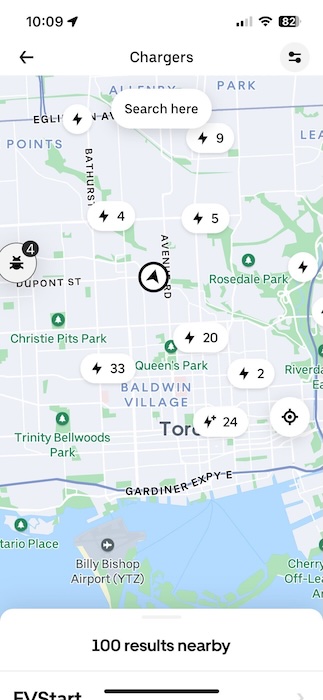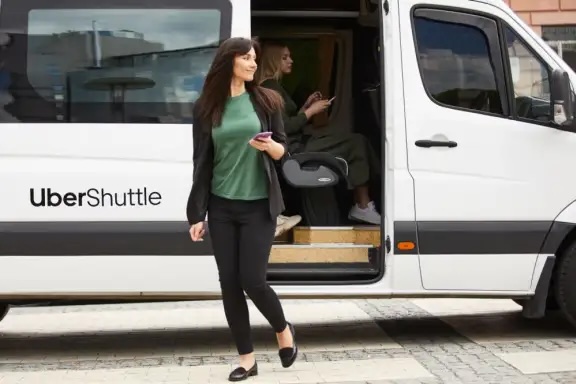Uber Canada shares its zero-emission goals, including an all-electric fleet, e-scooter ride booking capabilities and one-car households

Uber is bringing a suite of new zero-emission features to its platform in Canada. Photo: Uber Canada
Uber Canada shares its zero-emission goals, including an all-electric fleet, e-scooter ride booking capabilities and one-car households
It’s a rare day when, as a commuter, you can travel through an urban centre in Canada and not feel alternating surges of frustration and despondency by what you observe.
From bumper-to-bumper traffic on every paved surface from highway to driveway to the constant roar and smells of gas-burning engines, the prospect of road travel can be bleak.
It is against this backdrop that Uber is rolling out a series of services designed to make sustainable commuting a permanent and preferred lifestyle choice for Canadians.
“Around three years ago we made a decision as part of the Canada leadership team — even before Uber had made its global commitments — that we wanted to invest in shifting towards an electric future,” says Michael van Hemmen, general manager for Canada mobility at Uber, in an interview with Electric Autonomy.
“When we did that, we started to look at what are the ways that we could support the shift.”
What Uber came up with is a suite of services to make the experience of getting from place A to B as seamless and carbon efficient as possible.
Within the next nine months, Hemmen says, Canadian Uber customers should start to notice some significant changes to what the platform offers with a rapid, phased expansion of zero-emission services continuing through 2030.
“Uber has really ramped up its investments,” says Hemmen.
“The vision is by 2030 that [the Uber platform] will be fully electric in those major cities in Canada.”
Empowering Uber drivers
The first group that must be won over to Uber’s zero-emission roadmap is the life blood of the platform: the drivers.
Currently the Uber Green program in Canada classifies battery electric, plug-in hybrid and hybrid vehicles as “green” options. Van Hemmen says that while the classification worked well in the initial stages of the program, the intention is to, gradually, phase out hybrid vehicles from Uber Green and only count battery-electric vehicles.
“We’ve made really good progress to date, even by having hybrid and electric on the platform. Well over 25 per cent of all kilometres driven via the Uber platform in Vancouver are electric now. When we first started it would have been less than five,” says van Hemmen.

Reducing emissions further and building on the success, for Uber, begins in the driver’s seat. That makes providing education and support for electric, or, soon-to-be electric vehicle drivers, critical.
The most complete picture so far of what support programs may look like is on display overseas in London. There, Uber hosts EV education sessions, matches seasoned EV drivers with new adopters and offers an AI chatbot to answer EV-related questions.
In Canada, the programs and supports will be similar (Uber already has an in-app charging map for drivers available, for example), though are rolling out differently.
“We actually have a program that we that we run right now with Plug’n Drive,” says van Hemmen, referencing the Ontario-based non-profit EV education organization.
“It’s one thing for Uber to say, ‘switch and you will save money.’ It is a totally different conversation for a driver who’s done the switch to then talk to other drivers about that.”
Empowering Uber customers

As crucial to the program’s success are drivers, so too are Uber’s customers.
As part of the services offered on the Uber app, Canadian customers are able to track how carbon efficient they are being through the various methods of transportation they choose to use.
Very soon — sometime in the next six to nine months — van Hemmen says customers will be able to earn emission savings though new zero-emission transportation options on the app. They are planning to offer e-scooter rentals through the app — the first program of which is already available in East Vancouver with Lime as the e-scooter provider.
And, maybe one day, van Hemmen suggests, there will be features that track emission savings on transit trips, too.
The emission savings tracker is all part of Uber’s strategy to be “an aggregator” of services to support a sustainable lifestyle, says van Hemmen.
“Uber wants to provide a suite of options that allow you to get around your city how you want to, without having to own a car.”
Hurdles remain
On paper, Uber’s plan conjures a future of car-reduced, transit-filled urban centres and suburban driveways occupied with one car only.
But, van Hemmen admits, there remain hurdles that continue to hinder Uber (and many other companies) as they attempt to meet their zero-emission goals.
“The very first is cost for drivers. The second is access to charging,” says van Hemmen.
While Uber is attempting to solve the latter problem with its in-app charging map, the former is a pain point being felt everywhere and for which there are limited solutions.
Uber Canada currently offers drivers as much $5,000 in incentives to switch to an EV in addition to various federal and provincial EV purchase incentives offered across Canada. But for many drivers switching to a zero-emission vehicle feels like taking a financial risk.
“Uber operates different business models in a number of different countries. In Canada specifically, we’re much more dependent upon offering our services to drivers who own their own vehicles. Most drivers are driving for their own family needs and then they use Uber to get additional income for themselves,” explains van Hemmen.
“Although it takes more capital, it’s much easier to convince a business to make that decision — for them to do the math themselves — as opposed to a driver who’s using this car for their own life as well.”
Sharing zero-emission transportation
While Uber is preparing to roll out the next phase of emission saving features and services, it’s also making strategic moves in some new areas.

“Uber’s started moving into high capacity vehicles in North America for the first time,” says van Hemmen, referring to a new program called Uber Shuttle that launched in New York City between Manhattan and LaGuardia Airport on Oct 8.
Currently the shuttle is gas-powered, however Uber confirms that electrifying the shuttle is part of it’s all-electric 2030 vision.
This ties into a core social philosophy van Hemmen believes is a key solution to urban overcrowding, emission reduction and cost savings: sharing.
“With the population growth we have, there just isn’t room for everyone to have two or three cars… That doesn’t work,” he says.
“We need to share more and have shared rides be a part of that. We’re trying to get [non-electric] cars to put more and more people in the same vehicle. It has congestion benefits, but also emission per person benefits.”
Uber in Canada is “thinking bigger,” says van Hemmen. “Our vision, hopefully, is more broad.”






